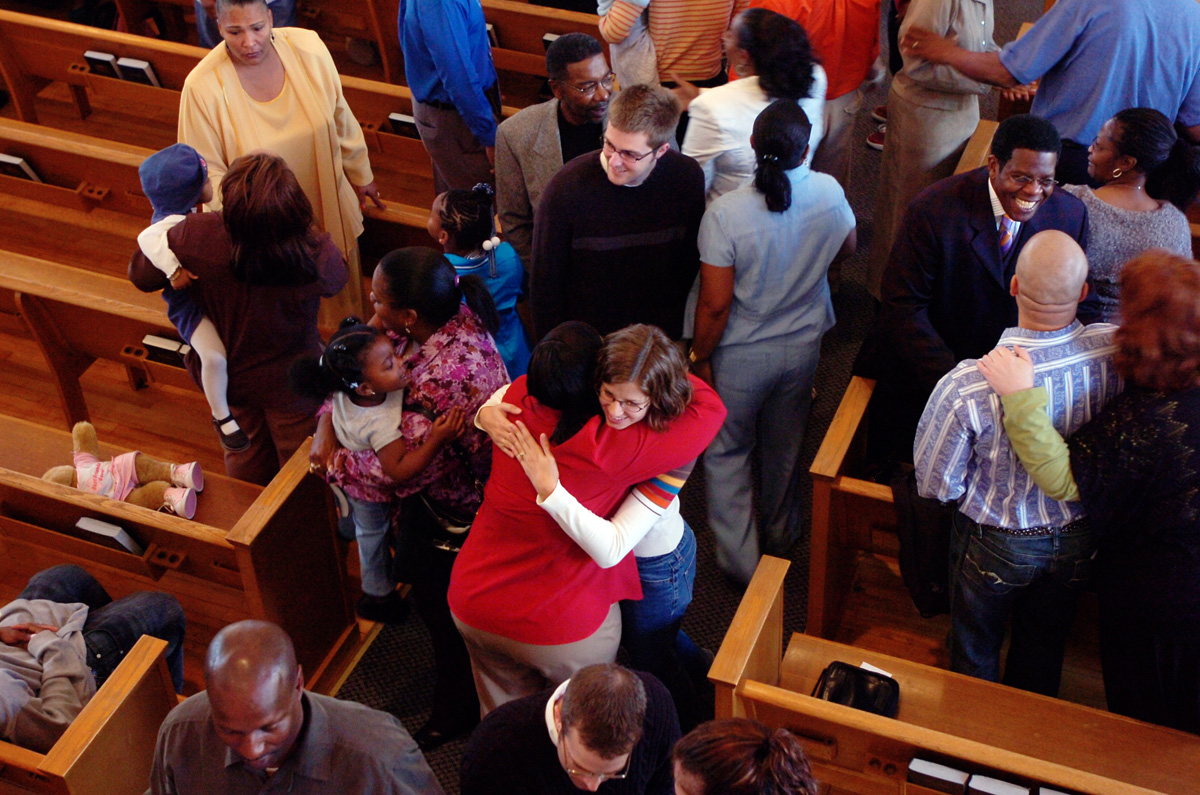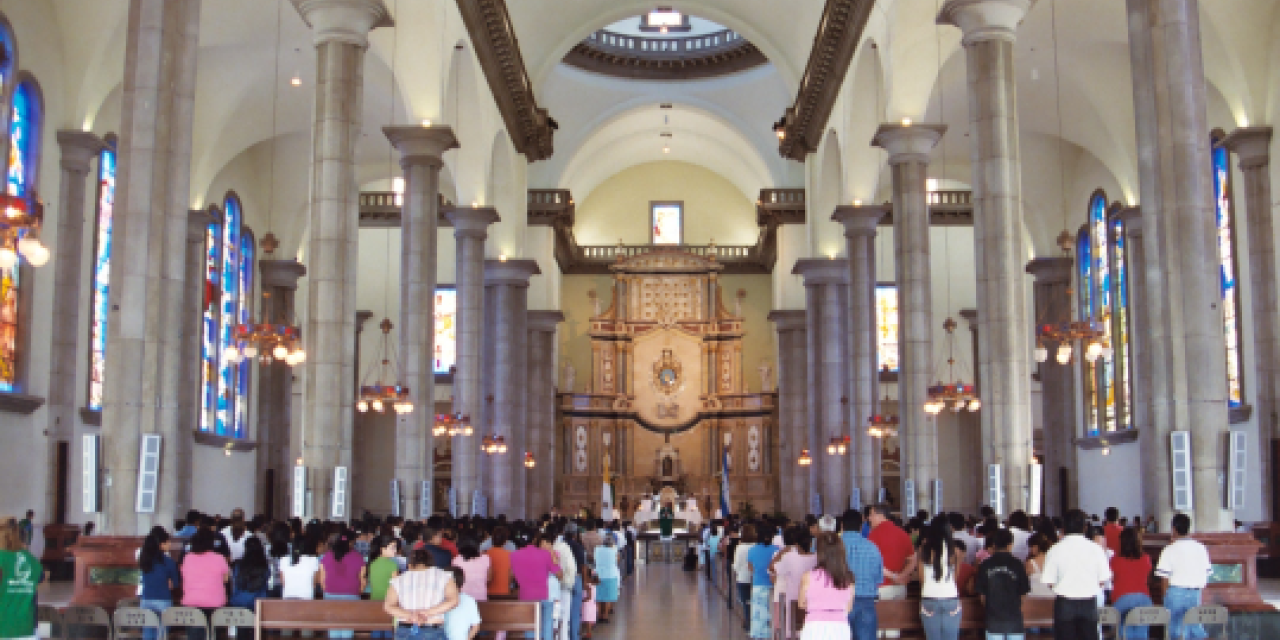Read Mystery Worshiper reviews on the Ship of Fools website and you’ll note stunning variety in what Christians do when they gather to worship God. That’s one reason why college religion and sociology professors and seminary worship professors assign students to observe worship.
And because it’s easiest for church visitors to default to their musical preferences, professors often provide templates to help students notice and describe the various parts of a worship service.
“I want students to always have some process for looking, seeing and hearing—because otherwise they’ll come back and describe how they felt. For this church visit exercise to work, we need a way to describe and analyze what is actually said and done and how that is faithful to a theological or liturgical tradition.
“I’m not saying that emotion doesn’t matter in worship, just that for this church visit exercise to work, you should not make your emotional reaction the content of your analysis,” says Jane Rogers Vann, professor emerita of Christian education at Union Presbyterian Seminary in Richmond, Virginia.
Whether or not you’re a teacher who sends students on church visits, you can adapt church observation processes to think more deeply about how worship shapes your life of faith.
Move from simplicity to complexity
When Emily Andrews gives freshmen and sophomores an assignment to observe worship and ministry activities of their own choosing, she doesn’t expect as much from them as she requires from more advanced students.
“Their reports often do not exhibit great depth and will feature many comparisons: ‘This church did this…but my church does it differently.’ They often focus on what surprised them and highlight their preference for their own congregation and its practices.
“While it wouldn’t pass in an ethnography course, this more relaxed approach helps students who are experiencing something new or not-their-home-church for the first time,” says Andrews, who teaches music and worship at Samford University in Birmingham, Alabama.
She notes that even simple comparisons help students become more aware of their own church traditions and practices. You might use this compare-and-contrast method with your church youth group or Christian high school students.
As Samford students gradually learn more about ethnography (detailed descriptions of everyday life and practices), Andrews says she expects them “to dive more deeply into participant-observation work in churches both within and outside their tradition or ecclesial context. Their reports provide greater detail and seek out ‘insider’ information on the context or event. Their assessments are more nuanced and demonstrate an advancing level of theological and pastoral wisdom. The most in-depth study happens in the student’s internship experience, a time in which students are asked to ‘exegete’ their congregation’s worship, people and context.”
Andrews provides her students with forms developed by her colleague Eric Mathis, who serves as Samford University area coordinator for music and worship, and director of anima: Forum for Worship and the Arts.
Visit outside your tradition
Tom Schwanda, who teaches Christian formation and worship at Wheaton College in Wheaton, Illinois, says he pushes students to visit churches very different from their own. “Depending upon their normal practices, that ‘very different’ church might be Orthodox, Roman Catholic, historically black or another ethnic experience. One key insight for students visiting other worship experiences is to prepare them, so as to reduce potential shock,” he says.
“In all my classes, students are required to visit a worship service outside their own tradition,” says Barbara Day Miller, associate dean of worship and music at Candler School of Theology: Emory University in Atlanta, Georgia.
Candler is a United Methodist Church seminary, but its students come from more than 50 denominations. Chapel services and church visits help them discern how specific worship practices form people spiritually.
“We gather in chapel for worship and prayer four days a week, with regular worship on Tuesdays and Thursdays, evensong on Wednesdays and mid-day Eucharist on Fridays,” Day Miller says.
One of her classes is Candler Singers. “It’s a select choir of 20 voices that leads worship in all different styles every week. As we rehearse the repertoire, we study hymnody from all periods, psalms (from chant to contemporary praise), service music and sung prayer from a wide range of traditions and denominations,” she says.
To navigate so much diversity, she asks students to structure their church observations and reports around four themes:
- Hospitality
- Is the space welcoming? Signage clear? People on hand to assist?
- Are the people hospitable? Were you welcomed? Informed as needed?
- Is the space accessible? Is it cared for?
- Word
- Who is included in the reading/hearing of God’s word?
- Was the scripture read clearly (one voice, drama, dance, etc.)?
- What is the “language” of the prayers? Who is included? How is God addressed?
- Who has voice?
- Music
- Variety of styles?
- Who is leading? Who is included?
- Well prepared?
- Does the music relate to the themes of the day/text?
- Sacrament
- Are the gestures strong and sure?
- Who assists and how?
- How is the assembly engaged, involved?
“Describe, analyze, imagine and plan”
Jane Rogers Vann assigns church visits for seminarians and for students in the PCUSA Christian Educator Certification program. Instead of describing music, preaching or scripture reading, she asks her students to observe liturgical actions. “In life, we can’t go anywhere without our bodies. If we don’t go with our bodies, we don’t go at all. Yet we rarely look into physical practices that form us,” she says.
Physical practices include bodily actions and gestures used for baptism, the Lord’s Supper, hospitality, welcome, prayer, blessing, the cross and other worship objects, processions and sacred dance. “When students observe and report on church worship, describing the non-inclusion of a liturgical activity or quality is also profound,” she says.
Before visiting churches, her students read her book Worship Matters: A Study for Congregations. Its chapters focus on the event of worship in space, the arts, liturgical action, days and seasons, language and music. “Each chapter concludes with a (long) series of questions that begin with a worship ‘ideal’ drawn from official denominational documents, the work of liturgical scholars and theological principles. Then readers are invited to describe, analyze, imagine and plan particular aspects of the worship they have experienced,” she says.
She invites students to choose two or three liturgical actions to observe in church visits. Two such examples quoted from her book are:
Ideal: The act of blessing by laying on of hands or raising of the hands conveys Christ's blessing. Sharing the peace of Christ acknowledges the presence of Christ’s spirit in every Christian.
- Describe the gestures of blessing most often used by the congregation. Describe the occasions for their use.
- Explain how these gestures convey blessing and acknowledge Christ's presence in every Christian. Explain the possible ways the gestures fail to convey blessing or convey some other message.
- Imagine possible changes in the congregation's practices of blessing. Imagine conversations that might help revise the congregation's ideas about social politeness, sincere touch, and God's blessing through human hands.
Ideal: The sign of the cross reflects the mark of God's ownership and the presence of Christ in persons and through the use of objects in worship such as the Bible, water, bread, and wine.
- Describe your congregation's use of the sign of the cross.
- Explain how it communicates God's ownership and Christ's presence.
- Imagine possible uses of the sign of the cross by worship leaders and members of the congregation. What relationship might its use have to "body memory" and spiritual formation?
Jane Rogers Vann’s approach works well for congregations that want to understand how regular worshipers and visitors experience their services. Imagine sharing this template with people from different ages and roles in your congregation.
Develop “appreciative curiosity”
“I have learned that what students learn from their participant/observer exercises is as dependent upon the student as upon the service they attend or the tool they use to shape their reports. An attitude of appreciative curiosity is as important as anything else,” Ron Rienstra says. He teaches preaching and worship arts at Western Theological Seminary in Holland, Michigan.
Rienstra trusts that seminarians who cultivate an appreciative curiosity about visiting churches can develop their own observation tools. He recommends these resources to get them started:
- A More Profound Alleluia by Leanne Van Dyk
- Chapter 1 of Beyond the Worship Wars: Building Vital and Faithful Worship by Thomas G. Long
- Disciples:Worship by Ron Rienstra
- Nairobi Statement on Worship and Culture
Jeremy Perigo teaches worship and directs music and worship programs at London School of Theology in London, United Kingdom. “At the 2016 Calvin Symposium on Worship, I went to Monique Ingalls’s workshop, ‘Understanding Your Congregation’s Unique Worship Culture.’ The ideas in her workshop handout, “Components of a Worship Culture’” will be very helpful as I assign students to observe church worship.
“Also, I have our MA students create their own evaluation tool by reading Michael A. Farley’s article ‘What is “Biblical”’ Worship? Biblical Hermenutics and Evangelical Theologies of Worship.’ It encourages students to begin to reflect more critically on various approaches of ‘biblical’ worship,” Perigo says.
Links
- Worship Matters: A Study for Congregations
- Audio: Understanding Your Congregation’s Unique Worship Culture
- Best Resources for Teaching Worship
LEARN MORE
Even people who lead worship in their own churches can find ways to visit other churches. Jane Rogers Vann suggests looking for a Saturday night service at a megachurch or an Episcopal evensong. Several congregations have used her book Worship Matters: A Study for Congregations in study groups. Read an edited conversation with Jane Rogers Vann on trusting the liturgy.
Use or adapt church visit observation forms from Samford University, Tom Schwanda, Calvin Institute of Christian Worship or Wabash Center for Teaching and Learning in Theology and Religion. For more ideas, listen to Monique Ingalls’ 2016 Calvin Symposium of Worship workshop, Understanding Your Congregation’s Unique Worship Culture.
Read The Next Worship: Glorifying God in a Diverse World by Sandra Maria Van Opstal. It will prepare you to appreciate worship that’s different from what you might think of as “normal worship.”
Christian Learning Center (CLC) Network consults with churches that want help discerning how well their worship services welcome people with disabilities.
If people who’ve been highly involved in your church suddenly start leaving, perhaps they sense a disconnect between worship and life. Josh Packard, a sociologist who studies religion in America, writes about people who describe themselves as done or almost done with organized Christian religion.
START A DISCUSSION
Feel free to print and distribute these stories at your staff, board, liturgy or worship meeting. These questions will help people plan visits to observe church worship or gather feedback on worship in your setting:
- Is observing church worship elsewhere encouraged or frowned on in your setting? What first step could you take toward encouraging people to visit churches and observe worship?
- If you attend worship when you’re away from home, how do you choose where to go? What have you learned from these visits?
- How might you create a worship observation form to learn what regular attendees and visitors notice about what’s said and done in your worship services?

